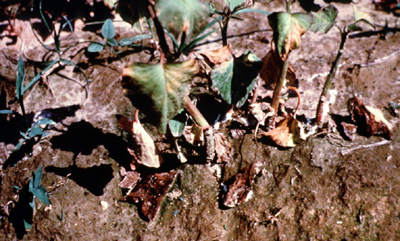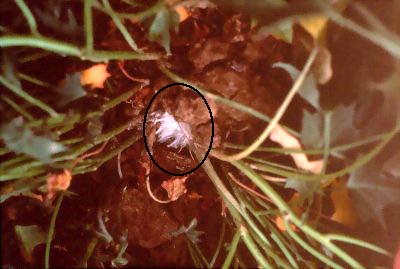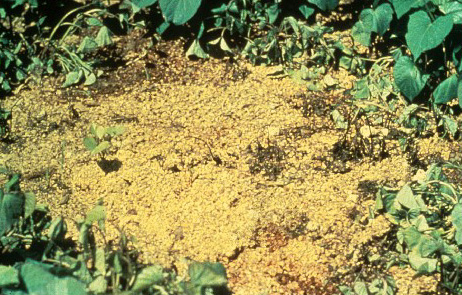|
| Kingdom |
Fungi |
| Phylum |
Basidiomycota |
| Class |
Basidiomycetes |
| Order |
Sterales |
| Family |
Corticiaceae |
The disease is quite serious especially in sweetpotato seedbeds. In the field
the disease is present at any stage of growth, but mostly scattered in patches
affecting several plants. Affected plants are girdled and usually die. Losses
are 5 - 20% in tropical areas due to dead plants.
The fungus attacks many hosts and is present worldwide. However, there
were only few reports on sweetpotato.
The disease usually appears as isolated patches in seed beds and in the
field, mainly when plants have grown to the stage where the foliage is dense
enough to cover the soil surface.
Plants initially show
yellowing of the lower leaves and wilting. In the stems, depressed, water
soaked, sunken lesions are usually observed
at or below the soil surface,
and they soon become covered with a white fan-like mycelium that radiates from
the lesion. Soon after, the stem is girdled and the plant eventually dies. The
fungus continues to grow in dead plants in the field, and when they start
drying, numerous sclerotia are formed. They are initially white but become
light brown, having the appearance of mustard seeds.
The mycelia are
white in early stages of development become tan as they mature and finally form
strands of brown pigmented hyphae. They measure 6-9 µm wide, have clamp
connections and numerous dikaryotic nuclei. The sclerotia
resemble mustard seeds, are round to irregular in shape, generally tan outside
and have a white medulla.
The basidial stage
has not been reported in sweetpotato.
S. rolfsii favours hot weather condition and prefers high temperatures
(28-30°C). It is present in tropical and subtropical areas of the world where
the temperature and relative humidity are high most of the time.
The fungus is a saprophyte that
kills the plant tissue in advance, producing pectolitic enzymes and cellulase,
which macerate the tissue. In the process, the cell walls and middle
lamellae are destroyed which facilitate infection. The fungus also produces high
amounts of oxalic acid.
During the growth period when senescent leaves drop to the soil, the fungus
starts growing on them and from there invades the base of the plant.
The pathogen survives in the soil for several years in plant residues in the
upper 10 cm or slightly below the soil line. It spreads by the mycelium growing
in the soil surface, or by mycelial fragments and sclerotia, by surface water,
or by mechanical means. Sclerotia can survive passage through the
digestive tract of cattle.
There is no significant difference in the growth of the pathogen in soils of
various textures and pH, except in clay loam soils, due to its conductivity. It
has also been suggested that soil pH is important for sclerotial formation.
Differences in virulence have been found. These might be due to the strain
present, because several strains have been identified based on oxalic acid and
enzymatic production.
S. rolfsii has several antagonists that live in the soil which can be
important for integrated disease management. Some of the most important
species tested in the laboratory and field are: Trichoderma harzianum, T.
hematum, Aspergillus flavus, A. niger, Gliocladium virens, Serratia marsescens,
Pseudomonas fluorescens, Xanthomonas campestris and Bacillus subtilis.
The fungus is omnivorous and is
recorded to live on more than 500 plant species. Sweetpotato (Ipomoea batatas)
is considered a primary host together with soybean (Glycine max), maize (Zea
mays), sunflower (Helianthus annuus), rice (Oryza sativa),
bean (Phaseolus vulgaris), groundnut (Arachis hipogaea),
cotton (Gossypium hirsutum), pea (Pisum sativum), black
pepper (Piper nigrum), sugarcane (Sacharum officinarum), tomato (Lycopersicon
esculentum), bell pepper (Capsicum annuum), carrot (Daucus carota),
potato (Solanum tuberosum), sugarbeet (Beta vulgaris var.
saccharifera), wheat (Triticum aestivum), lentil (Lens culinaris subsp.culinaris),
chickpea (Cicer arietinum), broad bean (Vicia faba), taro (Colocasia
esculenta), flax (Linum usitatissimun), turmeric (Curcuma
longa), etc.
Secondary hosts are numerous, among them food crops and ornamentals, most of
them economically important. There are also a variety of weed hosts.
Symptomatic plants or plant parts are placed in a moist
chamber for 3 to 4 days; abundant fan-like mycelia grow from them and in few a
more days, sclerotia start forming.
Cultural control
Deep plowing. The sclerotia do not survive when deeply buried into the
soil.
Crop rotation with non-host crops could be an effective control for
sweetpotato.
Use of soil amendments. Amendments can be added to the soil to stimulate the
increase of antagonistic microorganisms.
Solarization. Prior to establishing seedbeds, the soil may be covered with
black polyethylene sheets for a 6 week period during the hottest months of the
year. The top soil layers become very hot, effectively controlling the
fungus.
Host-plant resistance
Very little is mentioned about resistance of sweetpotato plants to S.
rolfsii. However, differences have been found in the reaction of certain
cultivars to artificial inoculation.
Chemical control
The most commonly cited fungicides to control S. rolfsii in several
crops are captan, quitozene, thiram, carbendazin, triadimenol, benomyl and
oxicarboxin; most of these can be used in sweetpotatoes as protectants where
soils are infected, and for dipping the cuttings before planting.
Aycock, R. 1966. Stem rot and other diseases caused by Sclerotium rolfsii
or the status of Rolfs’ fungus after 70 years. N.C. Agric. Exp. Stn. Tech.
Bull. No. 174 202 p.
Clark, C.A., and Moyer, J.M. 1988. Compendium of sweetpotato diseases. The
American Phytopahological Society. APS Press, Minnesota, USA. 74 p.
Mordue, J.E.M.
1974. Corticium rolfsii. CMI Descriptions of Pathogenic Fungi and
Bacteria No. 410. 2 p.
Contributed
by: Teresa Ames |
Taxonomy
Economic
importance
Geographical
distribution
Symptoms
Morphology
Biology
and ecology
Host
range
Inspection
and diagnosis
Management
References

Severely
infected plant after stems are girdled by Sclerotium
rolfsii (C. Clark,
APS).

An infected plant showing yellowing of lower leaves and
the characteristic white hyphae of the fungus (C.
Clark, APS).

An affected patch within a seed bed, where sprouts have been killed,
and brown granular sclerotia are formed on the mycelial mat (W. Martin,
APS)
|

